Everything to know about A's 2020 Draft
OAKLAND -- With a recent history of leaning toward college players when picking late in the first round, the A’s went against the grain at No. 26 on Wednesday with the selection of high school catcher Tyler Soderstrom, a premier bat who the club believes can greatly impact the game on both sides.
It was the first time a catcher was selected by the A’s in the first round since Landon Powell in 2004.
Day 2 fell a bit more in line with the usual A’s Draft strategy. All four picks were college players, including three right-handed pitchers.
Jeff Criswell, a versatile University of Michigan righty whose 2.72 ERA and 116 strikeouts in 106 innings as a sophomore in 2019 helped the school reach the College World Series, was the second-round pick. The fourth-round selection, Oklahoma right-hander Dane Acker, made headlines before the shutdown of the college baseball season when he tossed a nine-inning no-hitter against LSU in the Shriners Classic at Minute Maid Park on March 1.
Fifth-round pick Stevie Emanuels, out of the University of Washington, brings a solid starter’s complement of pitches that includes a fastball that can reach 94 mph and a wipeout slider. The lone position player taken on Day 2 was Georgia Tech outfielder Michael Guldberg. The A’s see him as a center fielder who can hit for a high average and play strong defense.
Now what?
The signing deadline this year is Aug. 1.
If a club exceeds its assigned pool, it faces a penalty. Teams that outspend their allotment by 0-5 percent pay a 75 percent tax on the overage. At higher thresholds, clubs lose future picks: a first-rounder and a 75 percent tax for surpassing their pool by more than 5 and up to 10 percent; a first- and a second-rounder and a 100 percent tax for more than 10 and up to 15 percent; and two first-rounders and a 100 percent tax for more than 15 percent.
In eight years with these rules, teams have exceeded their allotments a total of 149 times but never by more than 5 percent. Twenty-one of the 30 teams outspent their pools last year.
With the decrease to five rounds in this year’s Draft because of the impact of the COVID-19 pandemic, there’s a little more pressure to make sure each of those picks actually gets signed. Following the conclusion of Oakland’s final pick, A’s scouting director Eric Kubota expressed confidence the club would be able to sign all five of its draftees.
Of the five picks, Soderstrom is the most likely to command above the A’s first-round slot value of $2,653,400, given the Turlock High School product’s status as a UCLA commit. Criswell ($1,214,300 slot value), Guldberg ($593,100), Acker ($447,400) and Emanuels ($333,300) should fit within the team’s bonus pool of $5,241,500.
Trend wrap
The A’s Draft philosophy usually involves taking the best player available, regardless of position. That held even more true in this shortened Draft, with a trend coming in the form of college pitching. Three of the four players selected on Day 2 were college right-handers. While the first-round pick was a high school player who will require at least a few years to develop, the three pitchers selected by Oakland, especially Criswell, might not be too far away from the Major Leagues.
First-round fact
Soderstrom’s father, Steve, a first-round pick of the Giants in 1993, provided pitching lessons to A’s prospect Daulton Jefferies. Tyler has caught many of Jefferies’ offseason bullpen sessions over the past four years at Backyard Sports Academy, the facility Steve runs just a few minutes from Tyler’s home in Turlock, Calif.
Day 2 name to watch
Criswell was an intriguing name for many Draft experts because of his versatility. While his heavy fastball could play better as a reliever, nearly touching triple digits, Kubota believes Criswell has a good chance to stick as a starter, though Kubota noted some delivery issues that will need to be worked out. Criswell was MLB Pipeline analyst Jonathan Mayo’s favorite A’s pick. Mayo pointed out that the righty appeared to be pitching at his best in a relief role to help Michigan reach the College World Series in 2019.
NDFA strategy
Kubota revealed there are still a handful of names on the A’s Draft board who are now non-drafted free agents. The late rounds are usually when the A’s work their magic to find diamonds in the rough who end up contributing at the big league level, though that will be difficult to replicate this year with other teams likely targeting many of the same players.
The last word
“I think it was more similar to our normal process. We took the best prospects we felt were available when we picked. Now it’s kind of a fluid situation. The plan is, hopefully, to get the kids into Arizona based on their comfort levels of travel in the pandemic. We’ll see what the next step is after that.” -- scouting director Eric Kubota
